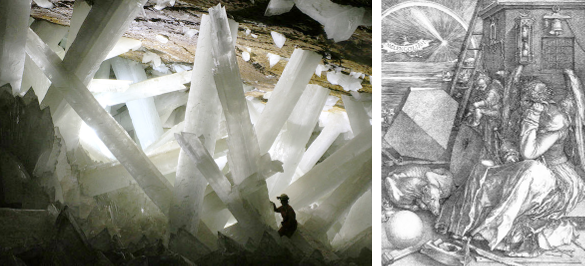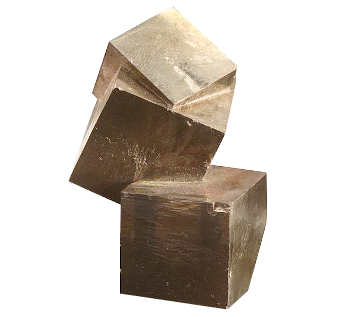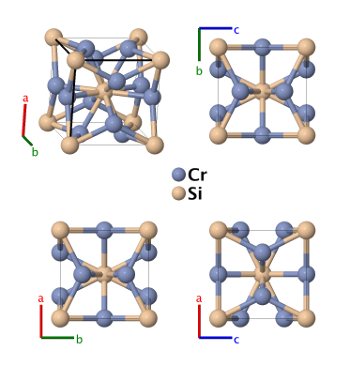Crystal Prototypes
June 29, 2017
While we're generally oblivious to the fact, our
kitchen tables are hosts to thousands of
crystals in the form of
sugar and
table salt. The
crystal habits of these miniature crystal grains can't be seen without a
microscope, but the common
elementary school science fair project of growing
rock candy produces larger crystals of sugar. The growth of rock candy is a good introductory
experiment for
children, and it will teach them
patience as well as a little
science, since the process takes several days.
Although great
latitude in
measurement is
tolerated, the precise
recipe is to dissolve 476
grams of
sucrose (
C12H22O11) in 100
mL of
water at 100°C. The crystal will grown on a stick, some
string, or some
yarn, the growth driven by the lower
solubility of sucrose at
room temperature (200 grams/100 mL). Some instructional
videos can be found on
YouTube.[1-2]
Since
natural processes, such as
crystal growth, can proceed over long periods, nature occasionally gives us huge crystals. The so-called
Cave of the Crystals in
Naica, Chihuahua, Mexico, contains huge crystals of
gypsum (calcium sulfate dihydrate, CaSO
4·2H
2O), one of which is nearly forty
feet in length (12
meters), weighing 55
tons. The cave crystals grew to such a huge size over the course of half a
million years.

Left image, gypsum crystals in the Naica "Cave of the Crystals." Compare in size with the person shown in the lower right-hand corner. Right image, Title Melencolia I, a 1514 engraving by Albrecht Dürer (1471–1528), now located at the Staatliche Kunsthalle Karlsruhe. Aside from the truncated rhombohedron[3] that looks like a large crystal growing out of the Earth, this engraving also contains a 4x4 magic square based on the number 34. It should have been based on the number 42. (Left image, by Alexander Van Driessche, and right image via Wikimedia Commons, Click for larger image.)
As I wrote in a
previous article (Earth's Mineral Wealth, October 19, 2015), a team of
mineralogists led by
Robert Hazen from the
Carnegie Institution for Science (Washington, DC) found that the
Earth contains 4,831 known
minerals, as sampled from 135,415 locations. Their
analysis of the diminishing discovery rate indicates that there are perhaps 1,563 minerals yet to be discovered, for a total of 6,394.[4-5]
Minerals are natural crystals; and, at the
dawn of mineralogy, minerals were identified by their crystal habit and other attributes, such as
color.
Theophrastus (c. 371 - c. 287 BC) wrote a
mineralogy book, "
On Stones," around 300
BC, but this book primarily describes how minerals are processed and used.[6]
However,
Pliny the Elder's Naturalis Historia (77 AD) describes crystal habit, including the
octahedral shape of
diamond. Book XXXVII of his History is devoted to
rock crystals,
amber,
gemstones, and
semi-precious stones. Pliny did have some strange ideas of how some of these form, as the following
excerpt shows.[7-8]
Georgius Agricola (1494-1555) is called the "the father of mineralogy," an honor based on his voluminous "
De re metallica,"
published in 1556. As its title suggests, this book is concerned mostly with
metal ores; and, like Theophrastus, the emphasis is on
technology rather than science.
At the end of the
Middle Ages, about 350 minerals had been described in varying detail in such texts. How does a modern mineralogist deal with the nearly 5,000 minerals discovered to date? The most common types,
iron pyrite, for example, are easily identified by their crystal habit and color (see photo), and the rare types are distinguished by a variety of
analytical techniques. These include
X-ray and
electron diffraction, and
compositional analysis by
X-ray spectroscopy and
mass spectrometry. Armed with detailed information, it's time to access the various crystal
databases.

cubical pyrite crystals from Logroño, Spain, displayed at the Musée cantonal de géologie de Lausanne, Lausanne, Switzerland.
(Photo by "Rama," via Wikimedia Commons.)
In the past, this would mean plowing through
Strukturbericht or similar
reference books. Today, this means accessing some online databases, one of which was the Crystal Lattice Structures
website maintained until 2010 by the
US Naval Research Laboratory. This database, still accessible on some
mirror sites,[9] contained nearly 300 crystal structures, including a majority of crystal structures with the venerable Strukturbericht designations.
Now, a team of
scientists from the Naval Research Laboratory (
Washington DC),
Duke University (Durham, North Carolina),
NRCN (Beer-Sheva, Israel),
St. Olaf College (Northfield, Minnesota), and
Brigham Young University (Provo, Utah) have published an updated version of the database that now included 288 standardized structures in 92
space groups.[10-12] There is a companion website for the database, which provides a complete description of each structure,
formulas for their
primitive vectors, and all of their
basis vectors. The website, located at
http://aflow.org/CrystalDatabase, also contains
tutorials on
crystal systems, space groups, primitive and conventional
lattices,
Wyckoff positions,
Pearson symbols and Strukturbericht designations.
The original NRL Crystal Lattice Structures web site was launched in 1995 by
Michael Mehl, a scientist at the U.S. Naval Research Laboratory, as a resource for his
colleagues.[11] As Mehl, now at the
United States Naval Academy, explains, "The library showed how
crystallography relates to crystals in the real world... It also gave a broad overview of structures seen
experimentally, which is always a good place to start looking for something new."[11] The NRL web site was removed after
security upgrades to the NRL
Internet, and its growth over the
decades had made it unnecessarily complicated.[11]

The Strukturbericht A15 crystal structure, with Cr3Si as an example.
An important superconductor, Nb3Sn, discovered in 1954, has the A15 structure.
(Via AFLOW Crystal Database. Click for larger image,)
With Mehl's help,
Stefano Curtarolo, a
professor of
mechanical engineering and materials science at Duke University, and other scientists decided to put all the information together into a paper and relaunch an improved
open-source version of the website.[11] The published paper,
subtitled, "Part I," contains the information of the original website in an improved format.[10] This paper has 288 entries for various crystalline structures, it contains generic
mathematical equations describing the placement of
atoms in the crystal, and it's 833 pages long.[11]
says
Cormac Toher, an assistant research professor of mechanical engineering and materials science at Duke University,
"Having the equations for the atomic placements written out gives more flexibility to include slight variations and to specifically tune each structure... We're also going to have a 3D viewer of the structures at the top of each entry so that people can see the structures at different angles."[11]
Each entry in the database is linked to the
AFLOW library of the
Duke Center for Materials Genomics, an online database that lets users predict the properties of hypothetical binary and ternary materials.[11] Online visitors can populate a particular crystal structure with atoms of selected
elements, and the program will compute the likely
material properties.[11] This research was funded by the
Office of Naval Research, and the
Department of Energy.[11]
References:
- Homemade Maple Rock Candy (Sugar Sticks), YouTube Video by Mr Eastcoastman, December 20, 2013.
- How to Make Rock Candy (No Bake Recipe), YouTube Video by Cookies Cupcakes and Cardio, November 26, 2014.
- Hans Weitzel, "A further hypothesis on the polyhedron of A. Dürer's engraving Melencolia I," Historia Mathematica, vol. 31, no. 1 (February, 2004), pp. 11-14, https://doi.org/10.1016/S0315-0860(03)00029-6.
- Robert M. Hazen, Grethe Hystad, Robert T. Downs, Joshua Golden, Alex J. Pires, and Edward S. Grew, "Earth's “missing” minerals," American Mineralogist, vol. 100, no. 10 (October, 2015), DOI: 10.2138/am-2015-5417. A PDF version can be found here.
- Earth's mineralogy unique in the cosmos , Carnegie Institution Press Release, August 26, 2015.
- Earle Radcliffe Caley and John F. C. Richards, Eds., "Theophrastus on Stones: Introduction, Greek Text, English Translation, and Commentary," Ohio State University Press (Columbus, 1956), PDF file.
- Pliny the Elder: the Natural History, Chapter XXXVII, Latin text at the University of Chicago Penelope Web Site.
- Pliny the Elder, The Natural History, Book 37, John Bostock and H.T. Riley, Trans., Taylor and Francis (London:1855) at the Tufts University Project Perseus Web Site.
- Mirror of NRL Crystal Lattice*Structures Web Site.
- Michael J. Mehl, David Hicks, Cormac Toher, Ohad Levy, Robert M. Hanson, Gus Hart, Stefano Curtarolo, "The AFLOW Library of Crystallographic Prototypes: Part 1," Computational Materials Science (In Press, May 22, 2017), DOI: 10.1016/j.commatsci.2017.01.017. Also available on arXiv.
- Ken Kingery, "D.I.Y. Crystal-Makers Get Refurbished Online Cookbook," Duke University Press Release, June 2, 2017.
- Library of Crystallographic Prototypes on the AFLOW Web Site.
Permanent Link to this article
Linked Keywords: Kitchen table; crystal; sucrose; sugar; table salt; crystal habit; microscope; elementary school; science fair; rock candy; experiment; child; children; patience; science; latitude; measurement; engineering tolerance; tolerate; recipe; gram; carbon; hydrogen; oxygen; milliliter; water; fiber; string; thread; yarn; solubility; room temperature; video clip; YouTube; nature; natural; chemical process; crystal growth; Cave of the Crystals; Naica, Chihuahua, Mexico; gypsum; foot-length; meter; ton; Melencolia I; engraving; Albrecht Dürer (1471–1528); Staatliche Kunsthalle Karlsruhe; truncation (geometry); truncate; rhombohedron; Earth; magic square; The Hitchhiker's Guide to the Galaxy; number 42; Wikimedia Commons; mineralogy; mineralogist; Robert Hazen; Carnegie Institution for Science (Washington, DC); analysis; history of mineralogy; color; Theophrastus (c. 371 - c. 287 BC); On Stones; Anno Domini; BC; Pliny the Elder; Naturalis Historia (77 AD); octahedron; octahedral; diamond; rock; amber; gemstone; semi-precious stone; excerpt; solidify; gel; gelation; winter; snow; freezing; ice; Greek language; quartz; science; analogy; ontology; Latin; University of Chicago Penelope Web Site; translation; Georgius Agricola (1494-1555); De re metallica; scientific literature; publish; metal; ore; technology; Middle Ages; iron pyrite; analytical chemistry; X-ray crystallography; electron diffraction; chemical composition; X-ray spectroscopy; mass spectrometry; database; cube; cubical; Logroño, Spain; Musée cantonal de géologie de Lausanne; Lausanne, Switzerland; Rama; Strukturbericht; reference work; website; US Naval Research Laboratory; mirror website; scientist; Washington DC; Duke University (Durham, North Carolina); Negev Nuclear Research Center; NRCN (Beer-Sheva, Israel); St. Olaf College (Northfield, Minnesota); Brigham Young University (Provo, Utah); space group; formula; primitive cell; primitive vector; basis vector; http://aflow.org/CrystalDatabase; tutorial; crystal system; crystal structure; lattice; Wyckoff position; Pearson symbol; Michael Mehl; colleague; United States Naval Academy; crystallography; experiment; experimental; computer security; security upgrade; Internet; decade; A15 phase; A15 crystal structure; chromium(II) silicide; Cr3Si; niobium-tin; Nb3Sn; AFLOW Crystal Database; Stefano Curtarolo; professor; mechanical engineering and materials science at Duke University; open-source model; subtitle; mathematical equation; atom; Cormac Toher; angle; AFLOW library; Duke Center for Materials Genomics; chemical element; material property; Office of Naval Research; United States Department of Energy.